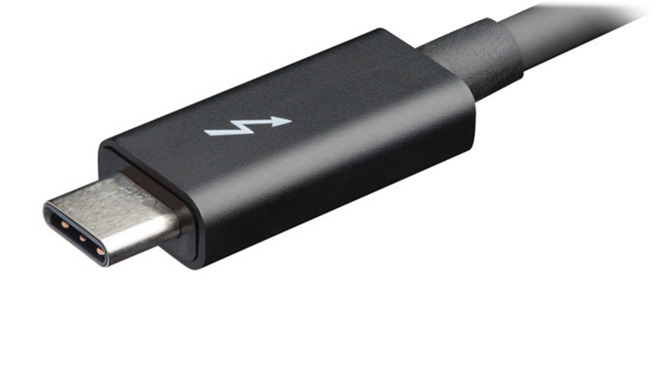New DisplayPort 2.0 spec uses Thunderbolt 3 for 16K displays
VESA has published the DisplayPort 2.0 video standard encompassing up to 16K displays -- and it uses USB-C and Thunderbolt 3 to do so.

VESA announced the DisplayPort 2.0 video standard, the first major update to the DisplayPort standard since March 2016, increasing data bandwidth performance up to three times more than the previous version of DisplayPort 1.4a.
DisplayPort 2.0 is backward compatible with previous versions of DisplayPort and includes all the key features of DisplayPort 1.4a, such as visually lossless Display Stream Compression, HDR metadata transport, and Forward Error Correction.
Utilizing the Thunderbolt 3 physical interface layer, DisplayPort 2.0 boosts the data bandwidth and promote convergence across industry-leading IO standards.
These new data rates will facilitate multi-stream transport of DisplayPort 2.0 devices for a single DisplayPort on the source device, driving multiple displays either via a docking station or displays that can be daisy-chained. It will also allow for simultaneous higher-speed USB data transfer without compromising display performance.
DisplayPort 2.0 also supports resolutions up to 16k, higher refresh rates, HDR support at higher resolutions, improved support for multiple displays, and improvements to augmented and virtual reality displays.
Specifically, single-display resolutions are 15260x8460 at 60Hz with compression, or 10240 x 4320 at 60Hz with compression. Daisy-chaining displays allows for two 8K displays at 120Hz, or three 10K displays at 60Hz, all with Thunderbolt 3. Using only two lanes with a non-Thunderbolt 3 USB-C cable, DP Alternate Mode allows for three 4K displays at 144Hz, two 4K x 4K for virtual reality at 120Hz, or three 2450 x 1440 displays at 120Hz.
According to the VESA press release, the first products incorporating DisplayPort 2.0 are projected to appear on the market by late 2020.

VESA announced the DisplayPort 2.0 video standard, the first major update to the DisplayPort standard since March 2016, increasing data bandwidth performance up to three times more than the previous version of DisplayPort 1.4a.
DisplayPort 2.0 is backward compatible with previous versions of DisplayPort and includes all the key features of DisplayPort 1.4a, such as visually lossless Display Stream Compression, HDR metadata transport, and Forward Error Correction.
Utilizing the Thunderbolt 3 physical interface layer, DisplayPort 2.0 boosts the data bandwidth and promote convergence across industry-leading IO standards.
These new data rates will facilitate multi-stream transport of DisplayPort 2.0 devices for a single DisplayPort on the source device, driving multiple displays either via a docking station or displays that can be daisy-chained. It will also allow for simultaneous higher-speed USB data transfer without compromising display performance.
DisplayPort 2.0 also supports resolutions up to 16k, higher refresh rates, HDR support at higher resolutions, improved support for multiple displays, and improvements to augmented and virtual reality displays.
Specifically, single-display resolutions are 15260x8460 at 60Hz with compression, or 10240 x 4320 at 60Hz with compression. Daisy-chaining displays allows for two 8K displays at 120Hz, or three 10K displays at 60Hz, all with Thunderbolt 3. Using only two lanes with a non-Thunderbolt 3 USB-C cable, DP Alternate Mode allows for three 4K displays at 144Hz, two 4K x 4K for virtual reality at 120Hz, or three 2450 x 1440 displays at 120Hz.
According to the VESA press release, the first products incorporating DisplayPort 2.0 are projected to appear on the market by late 2020.

Comments
going back to the beginning, Intel stated that in ten years TB would be at 100Gb/s. It’s still at 40. We know all about the cable “problem”, which DisplayPort now shares. But that problem can be overcome with amplified cabling. At a cost, of course. But are we now at the end of the TB advance> with Intel giving the license out for free—no more charging OEMs for ports, does that mean they’re letting go of TB altogether? Nobody knows that outside of Intel right now.
I'm interested in Mel's comments. His questions seem reasonable but they shouldn't affect any purchasing decisions that I will make. I don't have a negative impression of TB yet, but I do have a negative impression of USB-C with all of its complexity and different connector types. Maybe Intel can take the best of both and merge them into a single cable called USTB.
He may have been joking but I have to wonder what the use of anything beyond 10k is?
I can see it being useful for commercial purposes like theme parks and movie theaters.
No, the first connector was usb with an addition on the top. It was shot down by the usb group who didn’t want to allow a modified usb standard. You see, I said nobody would remember. You could have looked it up.
from Wikipedia:
CNET's Brooke Crothers said it was rumored that the early-2011 MacBook Pro update would include some sort of new data port, and he speculated it would be Light Peak (Thunderbolt).[35] At the time, there were no details on the physical implementation, and mock-ups appeared showing a system similar to the earlier Intel demos using a combined USB/Light Peak port.[36] Shortly before the release of the new machines, the USB Implementers Forum (USB-IF) announced they would not allow such a combination port, and that USB was not open to modification in that way.
link:
https://en.wikipedia.org/wiki/Thunderbolt_(interface)
It was more than a demo. I saw those early boards. But Apple was about to go into production with those connectors, and had to redesign their boards once Intel went to DisplayPort.